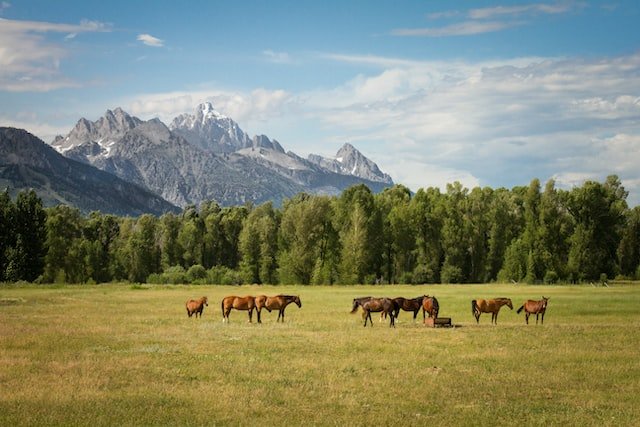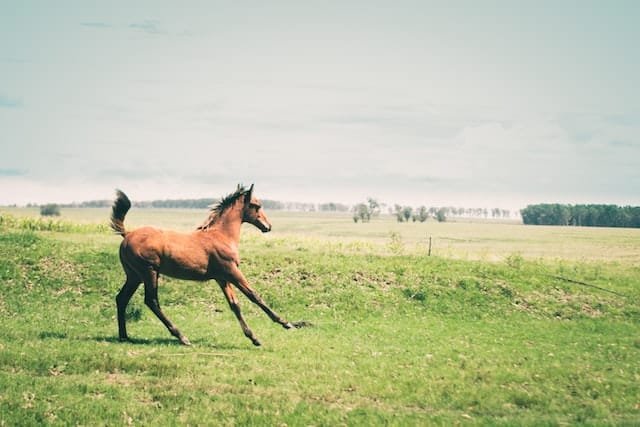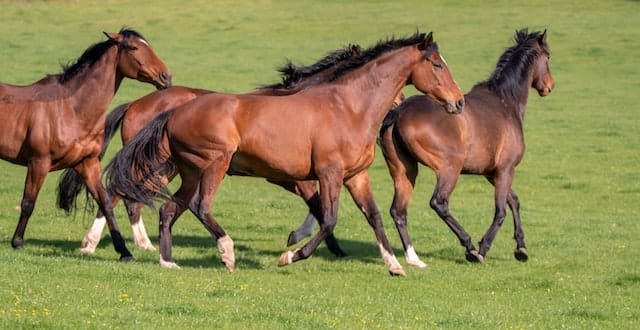Horses are one of the most incredibly adaptive creatures on this planet that have evolved and survived over 60 million years, and still going strong.
From the Eohippus – the earliest known ancestor of the horse to the modern horse – the Equus Caballus, this fascinating creature has changed with the times to become one the most loved animals and, unlike other animals, showing no signs of going extinct.
In this article, we will review 10 of the most fascinating horse adaptation facts that I found incredibly amazing. And I hope so do you.
Happy Reading!
10 Incredible Horse Adaptation Facts
The earliest known ancestor of the modern horse, the Eohippus, lived about 60 million years ago. It was as tall as a fox and lived in forests on a diet of leaves, fruit and nuts. Over the years the Eohippus gave way to many different variations of the horse, each version changing enough to survive and procreate.
In this manner, the horse always adapted to its environment and eventually evolved to become the Equus Caballus – the modern horse.

And here are the 10 most fascinating horse adaptation facts:
- Size: From 14-15 inches to 70 inches
- Colors: Changed for camouflage as the environment changed
- Jaws and Teeth: Evolved to grind grasses
- Digestive System: Can extract needed nutrition from grass and digest cellulose
- Legs: Evolved to run fast
- Hooves: Hardened to handle any surface
- Respiratory & Circulatory Systems: Evolved to provide extra bursts of energy
- Sharp Senses: Vision, Hearing, Tough, Smell and Taste – Evolved for Survival
- Living in Herds: Gave companionship and protection from predators
- Fear: Skittishness is the key to survival
Now let’s take a closer look at each of these horse adaptation facts and understand how they helped the horse evolve, survive and thrive.
#1. Size: From 14-15 inches to 70 inches
The Eohippus, as we saw above, was no bigger than a fox – about 14-15 inches tall. This size was fine for survival in the forests. But as the climate changed and forests gave way to grasslands, the horse had to adapt or perish.
The Eocene and Oligocene eras gave way to the Miocene and Pliocene eras and the smaller ancestors of the horse evolved into larger animals like the Kalobatippus and the Parahippus. The Parahippus, the size of a small pony, made way for the Merychippus which started resembling the modern horse we know so well.
Eventually, the modern horse the Equus Caballus started roaming the plains and some of them now reach a height of 70 inches.
So growth in size over tens of millions of years is one of the most interesting horse adaptation facts.
#2. Colors: Changed for camouflage as the environment changed
As horses changed in size, their colors too started adapting to their surroundings. Camouflage was and is the key to survival in the wild.
Early horses were brown and gray in color as these colors helped them blend in with the forest floor and avoid being preyed upon.
As the Horse family moved out of the forests and into the grasslands, their colors changed. Even today, some wild horses have a dun color which helps them blend in with the dry grasslands and avoid predators.
Colors of domesticated horses, however, have changed to a great extent to suit the whims and fancies of their human owners! This is more a result of selective breeding rather adaptation to the environment for camouflage.
#3. Jaws and Teeth: Evolved to grind grasses
As the horse’s diet changed from nuts, twigs and fruit in the forests to mostly grasses in the grasslands, their jaws and teeth adapted to enable them to grind these tough plants.
Horses have sharp incisor teeth to cut grass, hay and vegetation. They have three incisors on each side of the mouth of each jaw. They have three pre-molars and there-molars on each side with which they chew and grind the grass and hay.
To grind effectively, the upper and lower jaws are mirror images of each other having the same set of teeth.
One of the reasons why horses eat grass or why they can eat hay is that their bodies are made for it. Their jaws and teeth are able to turn the grass or hay into a thick mush from which their digestive tracts can extract the most nutrients.
#4. Digestive System: Can extract needed nutrition from grass and digest cellulose
All the grinding and chewing in the world would be of no use if the horse’s digestive system hadn’t been able to extract most nutrients out of the grass. And this is one of evolutionary science’s marvels.
Horses are herbivores. Yet they are highly muscular. How’s that? That’s because they are able to extract nutrients from vegetation that you or I will not be able to. Here’s how.
All plants contain a complex carbohydrate called Cellulose. Cellulose is the main component of a plant’s cell walls. Cellulose is what gives a plant its structure or its firmness. Cellulose is insoluble and indigestible in humans.
When we say we need to eat vegetables to get more fiber in our diets, the fiber we are referring to is cellulose. Cellulose passes through the human dietary tract undigested and it is cellulose that gives the bulk and roughage to our stools.
And the reason why cellulose passes through our stomachs virtually untouched is that the enzymes in our digestive tracts which are responsible for breaking down carbohydrates are unable to break down cellulose.
The horse and others in the equid family (rhinos, tapirs) have a little secret. They have special bacteria in their colons that can break down cellulose through a process called hindgut fermentation. Because of hindgut fermentation, horses can digest cellulose and extract much more nutrition from grass and hay than other animals. In fact, horses can get enough protein from hay to meet their needs.
This evolution of the digestive system is one of the most fascinating horse adaption facts out there.
#5. Legs: Evolved to run fast
Apart from being herbivores, horses are also prey animals. This means that, in the wild, they are at risk of being hunted and eaten by predators. Prey animals typically have razor-sharp fight-or-flight instincts. And when faced with a predator, horses prefer flight over fight. This is why horses run when afraid.
To be able to run fast, prey animals have evolved long and lean legs with large, powerful thigh muscles. A curious point of evolution is that horses have no muscles below the knee or hock. This gives them the freedom to most their legs easily and keeps them light.
Legs that are long relative to the body (and a powerful cardiovascular system) permit the horse to run for long and cover long distances. The horse’s legs are also designed for speed. Because in the wild, their predators are fast runners and so the horse has a need to run very fast and outrun its predators.
#6. Hooves: Hardened to handle any surface
The horse’s hooves are also adapted to allow the horse to walk or run on almost any surface. The hooves have a hard exterior made of a protein called keratin. This protects the horse’s foot and absorbs shocks whenever the horse runs on hard surfaces or tough terrains.
The hoof is in the shape of an incomplete crescent, where the incomplete portion includes the heel. This open-hoof structure provides some flexibility to the hoof to handle changes to the horse’s weight.
While in gallop, at times, the horse’s entire weight needs to be supported by a single leg. To protect the soles, the horse’s hoofs have a slanted wall. This makes the weight fall along the walls of the hoof.
The changes to the legs and the hooves are also some of the most amazing horse adaptation facts as they allowed the horse to get larger and heavier and still maintain its agility, speed and equilibrium.
#7. Respiratory & Circulatory Systems: Evolved to provide extra bursts of energy
When escaping a predator a horse will often need an extra burst of energy to run for its life (quite literally). The horse’s respiratory and circulatory systems are adapted for this survival function.
The role of the respiratory system is to take in oxygen and expel carbon dioxide. The circulatory system is responsible for distributing oxygen to various parts of the body that need it.
An interesting adaptation that the horse has is that its spleen stores extra red blood cells. When the horse starts running and its respiratory system is unable to provide additional oxygen fast enough, the stored red blood cells from the spleen are released into the bloodstream providing badly needed oxygen to its muscles.
This is again one of the many horse adaptation facts that has helped the horse escape predators and in doing so escape extinction.
#8. Sharp Senses: Vision, Hearing, Touch, Smell and Taste – All Evolved for Survival
Horses have their eyes on the side of their heads and so have a field of vision of almost 350 degrees. This allows them to see predators coming from any direction and also gives them a clear view of their surroundings.
Horses are also able to see some color. This is another one of the many adaptation facts that help the horse identify predators and their surroundings.
Horses have mobile ears. This means they can move their ears to face the direction of the sound. This is an adaptation that allows horses to identify predators and also other horses. Plus they have a flexible neck. The combination of flexible ears and neck allows the horse to have an almost complete range of hearing.
Have you seen a horse using its tail to swat files? How does it know a fly is sitting on its back? Because horses can feel small touches on their skin due to the high density of nerve endings in their skin. Since the horse cannot see every part of its body, this adaptation is crucial for the horse to identify predators that may be touching its body.
Horses also have a very keen sense of smell and can identify other horses, predators, and their surroundings using their sense of smell. They can also use smell to detect something unwanted in their food.
They also have a very developed sense of taste which allows them to identify food sources. Taste can also help horses identify something that may be harmful to them.
All these primary senses have evolved over the years and play an important role in the horse’s survival.
#9. Living in Herds: Gave companionship and protection from predators
In the wild horses live in herds. Living in herds is a social adaptation. With a herd, there is strength in numbers. A herd is able to protect its members from predators. Many predators will avoid attacking a member of a herd. But if a herd is attacked it will often repel the predator as a single unit.
When a herd of horses travels, the foals and old horses are often in the middle while stronger members of the herd are on the outer edges. This arrangement protects the weakest members of the herd from being attacked by predators.
The horse is also a social animal. A herd offers companionship. This herd behavior is retained in the domesticated horse. This is why a horse owner will often find a companion animal for their horse. This could be another horse, a donkey, a dog, or even a goat. In fact, goats can be great companions because goats can help calm down a horse.
#10. Fear: Skittishness is the key to survival
As you know for sure, horses are afraid of many things. Being prey animals, they are always on the lookout for predators. That makes them skittish. But this skittishness is an adaptation that has helped the horse survive for thousands of years.
A skittish horse is more likely to flee when a predator is near. A skittish horse is more likely to sense danger before it is upon them. So as they say – fear is the key. And with the horse, fear keeps it on its toes and alive.
Final Thoughts
Horses have evolved over millions of years in fascinating ways. This evolution has permitted them to evade predators, survive in changing environments, and travel great distances in search of food and water. The horse is a true survivor. We hope you liked the various horse adaptation facts that we reviewed in this article.



